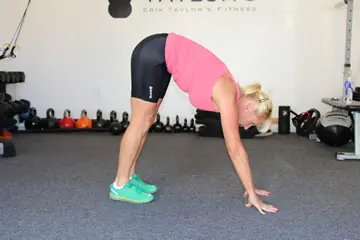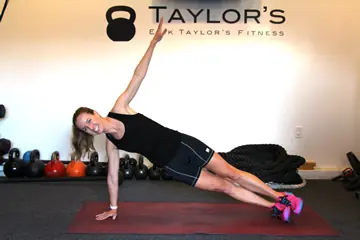Stretches That Also Strengthen

1 of 9
Resistance stretching is all the rage among elite Olympic athletes, but can something as simple as just a stretch make you stronger? Yes, says Michael Schiemer, B.S., CPT, and owner of Frugal Fitness. Plus, it "is an excellent way to increase strength while improving range of motion, reducing injury, and avoiding excess muscle mass gain." Even better, it needs no equipment! To try it for yourself, Schiemer recommends eight of his favorite moves.
Resisted Hip Flexion

2 of 9
Lie on your back wiith knees bent and feet flat. Bring your right knee up to your chest, placing both hands on top of leg, just above the knee. As you push down on your leg, resist the downward force by contracting your hip flexor muscles. Once the heel of your foot taps the mat, bring that knee back up to your chest again, pushing against your hands' resistance. Do 10-15 slow repetitions and repeat on your left leg.
Tip: Make sure to keep your neck relaxed and your lower back flat against the mat throughout this movement.
Resisted Neck Twist

3 of 9
Sit up straight with your core tight and shoulders relaxed. Place your right hand against your right cheek. Against the light resistance of your hand, rotate your head to the left about 90 degrees. Slowly return back to the starting position, still pushing against your hand. Repeat with the opposite arm and rotate to the opposite side. Start with 5 reps on each side using very light resistance.
Tip: Use this carefully, especially if you have a stiff neck. Don't do it if you have any concerns about your neck or spine.
Resisted Biceps Flexion

4 of 9
Start with your right arm in a fully flexed position so that your elbow is at your side and your palm is close to your shoulder (palm facing up). Take your left hand and place it on your forearm to apply resistance. Push down with your left hand as you resist the downward force with your contracted biceps until your arm is fully extended and then slowly return back to the starting position, still pushing against resistance. Do 10-15 reps and then repeat with the opposite arm.
Tip: Keep the movement slow and smooth even if that means you need to do fewer reps.
Resisted Triceps Extension

5 of 9
Stand with your right arm so that your elbow is at your side and your arm is straight out in front of you, palm facing up. Place your left hand on the back of your forearm to apply resistance. Slowly resist the elbow flexion with your triceps until your elbow is as flexed as possible and then slowly straighten the arm to starting position against resistance. Do 10-15 reps and repeat with the opposite arm.
Tip: Use your left arm instead of your hand if you need more resistance.
Partner-Resisted Hamstring

6 of 9
Lie on your stomach. Bend one leg so that the heel of your foot is close to the back of your leg. Have your partner kneel beside you and put one hand under your calf and the other right above the ankle to apply resistance. Resist as your partner pushes back on your lower leg until your leg is completely straightened. Continue resisting against your partner until your leg is bent again and heel is against the back of your leg. Repeat with the opposite leg.
Tip: Make sure your partner isn't putting any pressure on your knee joint.
Partner-Resisted Quadriceps

7 of 9
Start lying on your stomach on a mat. Start with both legs fully extended out and your partner's palm above the laces of your shoes or shin to apply resistance. Flex your quadriceps (thigh) muscle and resist against your partner until your knee is between a 90-degree bend and against your the back of your leg. Then, continue the resistance until your leg has straightened completely again and you have returned to the starting position. Do 10-15 reps and repeat with the opposite leg.
Tip: Make sure to keep your lower back flat the whole time.
Partner-Resisted Chest and Front Shoulder

8 of 9
Stand with one arm relaxed at your side and one arm straight out in front of you and parallel to the floor. Your partner will be on the side of the extended arm and holding the inside of your forearm to apply the resistance. Contract your chest muscles to resist as your partner pulls your arm away from your body until your arm is completely out to the side. Keep resisting as you bring your arm straight out in front of you again. Do 10-15 reps and repeat with the opposite shoulder.
Tip: Keep your hips square to the front; don't let your body twist towards your partner.
Partner-Resisted Upper Back and Rear Shoulder

9 of 9
Stand with one arm relaxed at your side and one arm straight out to the side and parallel to the floor. Have your partner stand on the same side as your extended arm and apply resistance against the back of your arm to push it back in towards the body. Resist as your partner pushes your arm back across your body until it is straight out in front of you and perpendicular to your torso. Continue pulling back against the resistance until your arm is back to the starting position straight out to the side. Do 10-15 reps and repeat with the opposite shoulder.
Tip: Make sure your partner isn't putting any pressure directly on your elbow joint.
Original article and pictures take www.shape.com site
/GettyImages-476804187-56a2b7e45f9b58b7d0cdb52a.jpg)
/standinghamstring-56a2b7d75f9b58b7d0cdb4d4.jpg)
/stretchchest-56a2b7d75f9b58b7d0cdb4d8.jpg)
/upperbackstretch-56a2b7d75f9b58b7d0cdb4db.jpg)












